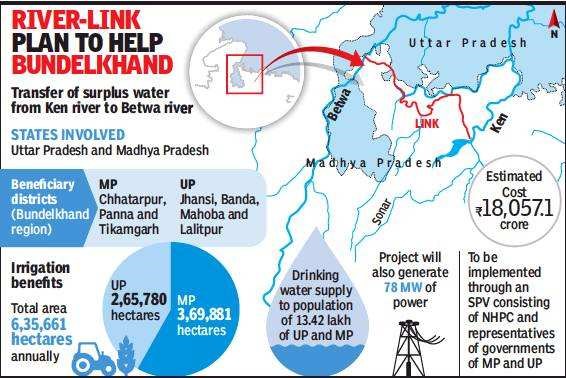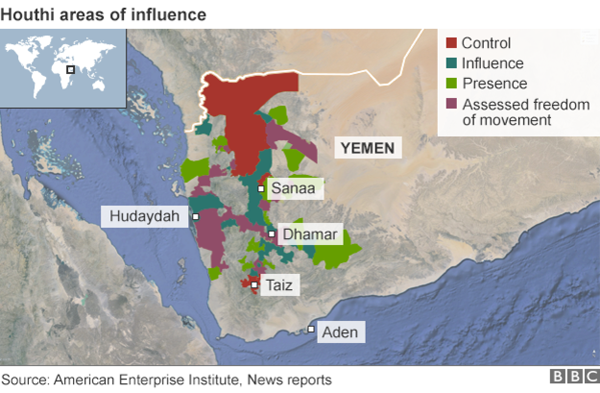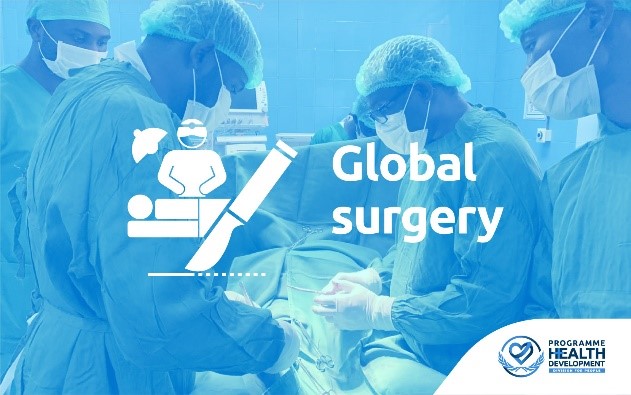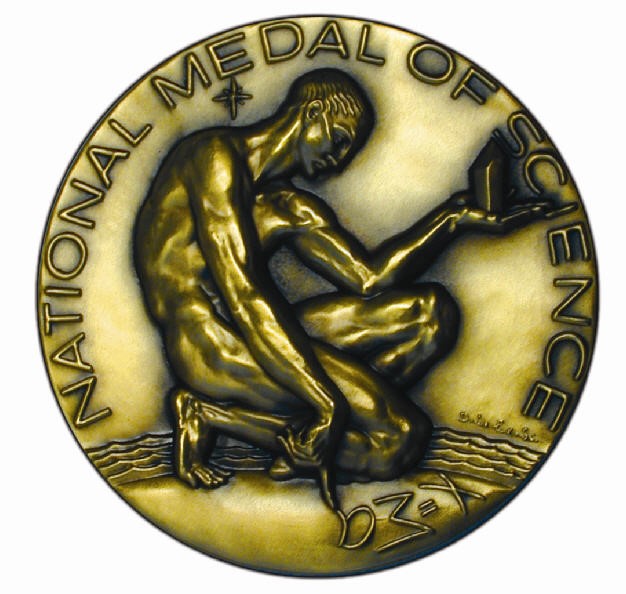1. Madhya Pradesh’s Ken-Betwa River Project
Introduction:
The Ken-Betwa river interlinking project, a notable undertaking initiated by the Madhya Pradesh government and part of the broader national plan, has faced scrutiny.
Overview of the Project and Violations:
Commencing construction in 2019, the Lower Orr dam, a component of the second phase of the Ken-Betwa river interlinking project, has raised concerns.
Violations of Clearance Laws:
In 2022, an expert appraisal committee (EAC) revealed that the project started without obtaining formal clearance from the Environment Ministry.
Incomplete Construction:
The latest report indicates that approximately 82% of the dam and 33.5% of the canal network were completed without the required clearances.
EAC’s Recent Recommendations:
In December 2023, the EAC urged a fresh evaluation and additional data on potential construction-related damage.
What is the Ken Betwa Link Project?
First of its Kind:
This initiative marks the inaugural project under the National Perspective Plan for interlinking Indian rivers.
River Linking:
It entails the transfer of water from the Ken River to the Betwa River, both tributaries of the Yamuna.
Phases of the Project:
Phase-I Components include the Daudhan dam complex, Low Level Tunnel, High Level Tunnel, Ken-Betwa link canal, and Power houses. Phase-II Components involve the construction of the Lower Orr dam, Bina complex project, and Kotha barrage.
Utility of the Project:
Irrigation Benefits:The project aims to irrigate 10.62 lakh hectares annually.
Drinking Water Supply:It is expected to provide drinking water to 62 lakh people.
Power Generation:The project will generate 103 MW of hydropower and 27 MW of solar power.
Regional Development:
It promises socio-economic prosperity to the Bundelkhand region through increased agricultural activities and employment, combating rural distress and distress migration.
Ecological Issues with the Project:
- Scientific Basis: Concerns have been raised about the ‘surplus and deficit’ model and the availability of water in the Ken River.
- Water Sharing Disputes: Disagreements over water sharing, especially during non-monsoonal months, have occurred between Uttar Pradesh and Madhya Pradesh.
- Environmental Impact: The project involves creating a reservoir dam in the Panna National Park and Tiger Reserve, impacting the downstream Ken Gharial Sanctuary. National Board for Wildlife approval, as required by the Wildlife (Protection) Act, 1972, has not been confirmed.
Issues with the Projects:
Displacement:Significant displacement of people is anticipated.
Topographical Changes:The flat topography of the Ganga basin poses challenges for dam construction.
Inundation and Seismic Hazards: Large-scale water transfer risks inundating forests and creating seismic hazards in the Himalayan region.
Financial and Political Challenges:The project requires substantial financial investment and political support.
Land Acquisition and Ecological Feasibility:Consensus building for land acquisition and addressing ecological concerns are significant hurdles.
Criticisms of Such Projects:
- Questionable Science:Critics argue that these projects rely on outdated water management understanding.
- Contravention with Nature:They are perceived as going against natural processes, posing more threats than opportunities.
Way Forward:
Expert Scrutiny:Thorough and independent expert scrutiny during the approval stage is crucial.
Independent Hydrological Study:A comprehensive study of these rivers is necessary to assess feasibility and impact.
Conclusion:
Developmental projects like the Ken-Betwa Link should not compromise fragile ecosystems or important wildlife habitats. The potential destructive impact on water flow and sanctuary ecosystems, along with legal compliance, requires clear assessment and consideration.
Sound environmental governance and due diligence are essential in balancing developmental needs with ecological preservation.
2. Houthi Rebels and Regional Dynamics
Introduction
Military interventions against Houthi groups in Yemen were launched by the United States and the United Kingdom on January 11. This military action is a direct response to the persistent acts of aggression by the Houthis against maritime vessels in the Red Sea, a critical global trade route.
Background of the Conflict
- Houthi Attacks on Shipping: Since November 2023, Houthi forces have been actively targeting ships in the Red Sea and Gulf of Aden, causing disruptions in one of the world’s busiest maritime trade routes.
- Israeli-Hamas Conflict: The Houthis’ actions stem from the Israeli military’s bombardment of Gaza following an attack by Hamas on October 7, resulting in significant casualties.
Houthi Group and Regional Dynamics
- Who Are the Houthis?: The Houthis, a Shia militant group, are deeply involved in the civil war in Yemen, exerting control over substantial parts of the country, including the capital, Sana’a.
- Regional Rivalries: The conflict reflects enduring regional rivalries, with Iran supporting the Houthis and Saudi Arabia backing the Yemeni government. The Houthis’ participation in the Israel-Hamas conflict is viewed within this broader regional context.
Concerns for Global Trade
Impact on World Trade: Approximately 12% of global trade passes through the Red Sea and Suez Canal, underscoring the critical importance of securing this route.
Alternative Routes: Due to safety concerns, some vessels have been redirected around the Cape of Good Hope, leading to increased transit times and higher fuel costs.
Implications for the Region
- Operation Prosperity Guardian: Initiated by the United States, this coalition aims to ensure maritime security in the region. However, partner countries have exhibited reluctance to contribute significantly.
- Risks of Wider Conflict: There are growing concerns about the conflict expanding beyond Israel and Gaza, potentially resulting in unpredictable outcomes in the Middle East.
Impact on Yemeni Peace Negotiations: The military strikes may have repercussions on the ongoing peace negotiations in Yemen, facilitated by Oman and the United Nations.
3. GLOBAL SURGERY
Global surgery faces a concerning lack of attention within the realm of global health, particularly in South Asia, home to the world’s largest population without proper access to essential surgical services.
Overview of Global Surgery:
– Objective: The primary goal is to ensure equitable access to emergency and essential surgical services.
– Focus: The main focus is on addressing access disparities in low- and middle-income countries (LMICs).
– Inclusive Approach: The scope extends beyond LMICs to include targeted efforts to address access discrepancies in high-income countries (HICs).
– Surgical Services: The term “surgeries” here encompasses vital procedures such as surgery, obstetrics, trauma, and anesthesia (SOTA).
– Consensus on Procedures: Despite minor variations, there is a broad consensus among various international groups regarding approximately thirty procedures falling within the realm of emergency and essential surgery.
Global Consensus on Global Surgery:
- A significant development in this transformation was the Disease Control Priorities Network (DCPN) report on essential surgery sponsored by the World Bank.
- The Lancet Commission on Global Surgery (LCoGS) played a pivotal role by bringing together experts and stakeholders to:
– Assess the global status of surgical care access.
– Propose indicators for monitoring surgical care preparedness.
– Evaluate systemic capacity and impact.
– Develop implementable strategies, such as the national surgical, obstetrics, and anesthesia plan (NSOAP).
4. NATIONAL SCIENCE AWARD
Context:
The government has recently issued a call for nominations and applications for the newly established national science award known as Rashtriya Vigyan Puraskar (RVP).
This award aims to honor individuals or teams who have made significant contributions in diverse fields of science, technology, and tech-led innovation.
Rashtriya Vigyan Puraskar (RVP):
– Similarity to Padma Awards: Modeled after the prestigious Padma awards, the RVP does not include any monetary reward. Instead, recipients are expected to receive a certificate and a medallion.
– Award Frequency: The RVP is presented annually.
– Covered Categories: The award spans across 13 categories, encompassing physics, chemistry, biological sciences, mathematics and computer science, earth science, medicine, engineering science, agricultural science, environmental science, technology and innovation, atomic energy, space science and technology. Additionally, there is a 13th category simply labeled as ‘Others.’
– Highest Recognition: The RVP is recognized as one of the most prestigious accolades in the realms of science, technology, and innovation within India.
– Eligibility: The award is open to scientists, technologists, and innovators working in government, private sector organizations, or individuals operating independently.
– Award Announcement: The RVP recipients are announced on National Technology Day.





